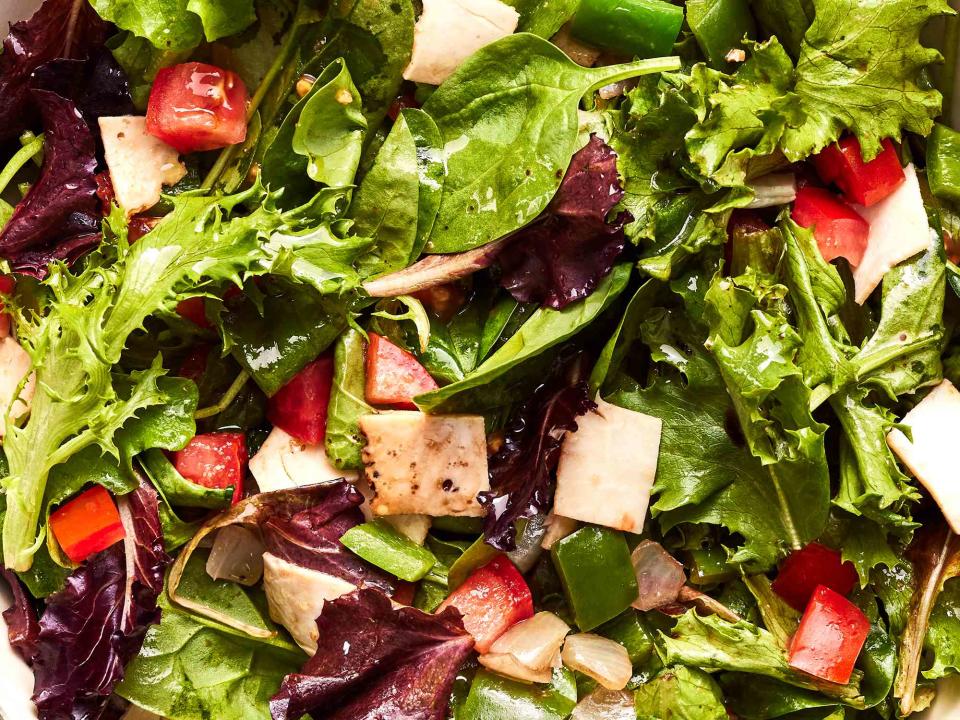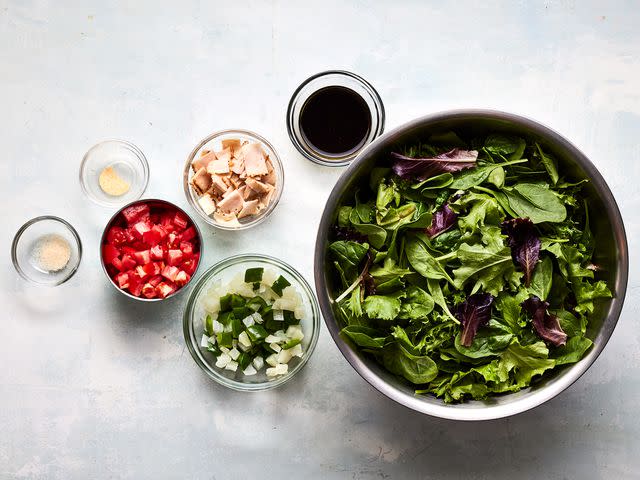How to Store Your Salad So It Lasts Longer in the Fridge
Follow these pro tips for prep and storage that will give your salad a much better chance of lasting longer (and keeping its crunch!).

Dotdash Meredith Food Studios
Your salad experience should be a positive one because life is too short for limp lettuce and soggy croutons. And while you might think that means devouring what you built in that salad bowl the same day (or maybe tomorrow lunch at the latest), it turns out you can keep your salads fresh for considerably longer. From simple assembling strategies to smart storage, here are our best-kept secrets to eternal (okay, not quite eternal but still much longer) salad life.
First, here’s why salads don’t last forever
Salads, whether made up of vegetables and/or grains, are a highly perishable food. That's because as soon as plants are removed from the soil, they no longer have a source for water or food to keep them going. So for every day they're not receiving those things is another day where they become less vibrant and fresh.
Beyond that, many salads contain ingredients that are both delicate (leafy greens, we're talking to you) and have a high moisture content. Delicate things tossed with heavy things and liquid things never work long-term. And those high-moisture foods, while great when consumed right away, will lose their liquid especially if exposed to salt. This can lead to a murky pool of water at the bottom of the salad container. And that moisture can lead to deterioration of your salad ingredients. One bad thing leads to another, in other words.
So, how do you get around these obstacles? How do you keep your salads fresh longer? Here are our top 9 tips, tricks, and techniques to keep that crunch.

Dotdash Meredith Food Studios
Make sure things are dry before you assemble
Moisture is the enemy for many salad ingredients. If you're cutting vegetables, cooking grains, or draining canned foods, be sure to pat them dry before adding them to your salad. If an ingredient is particularly high in moisture, such as a cucumber, consider waiting to cut it or cut and place in a separate container instead of adding directly to your salad (more on that below).
For leafy greens, add paper towels
Before storing your greens in the fridge, ensure that they are completely dry, says healthy living coach Nina Cherie Franklin, PhD, (aka That Salad Lady). She recommends placing paper towels between layers of leaves to prevent browning, wilting, and spoilage. If you plan to use a plastic bag for storage, be sure to press out any excess air. With a storage container, ensure that it's tightly sealed. Store greens in the crisper drawer for best results.
Select and store your ingredients carefully
Franklin recommends that cheeses, berries, and tomatoes—along with cooked ingredients (shrimp, chicken, egg, and bacon)—should be stored in their own separate containers in the fridge. So should any other proteins, whether they are animal-based or plant-based (tofu and quinoa). These ingredients make for a great salad, Franklin says, but can also make it soggy, slimy, sticky, smelly, and sloppy when it sits for too long.
Salads made with firm, more durable chopped vegetables do fine stored together in the fridge, Franklin says. Brussels sprouts, broccoli, cabbage, carrot, and onions can all withstand a good amount of moisture and can be stored in an airtight container for maximum longevity. Bell peppers and cucumber are also on the firmer side but—if not eaten within one to two days—should be stored in separate containers, as they tend to spoil faster than the others.
Don’t forget to label
Beyond stocking up on lidded storage containers or silicone bags to keep your ingredients at the ready for assembly time, add labels with the date each item was prepped so you can consume them before they begin to go bad. Dana Angelo White, a registered dietitian, nutritionist, and certified athletic trainer likes quart containers (like the kind you get at the deli counter) for storing grain salads. "They are dishwasher and freezer safe and are perfect for packing food to go or storing in the fridge for meal prep," she says.
Build smart
Delicate ingredients including leafy greens, microgreens, and fresh herbs can get smashed by heavier ingredients in your salad bowl. And wet ingredients can create a swampy environment for your salad. Take those factors into consideration when building your dish; one option is to place the heavier ingredients in the bottom of the bowl and layer the lighter ingredients on top. For wet ingredients, it might be best to keep them separate and add them just before tossing and serving. And that goes for salad dressing as well.
Add shelf-stable ingredients just before tossing
Some ingredients, including dried fruits and nuts, will absorb water, which could make them soggy and unappealing. They're best if left at room temperature and added just before tossing the salad.
Keep crispy stuff and cheesy stuff off
Since a salad is typically a high-moisture dish, it's best to keep anything crispy or cheesy off until serving. Crispy items such as croutons or fried wontons will become soggy and cheese will become soft.
Pick the right spot in the refrigerator
Where you store your salad matters. White advises never to store salad on the bottom or back of the fridge. Instead, store prepared foods like salad on the higher, top shelves, to prevent any chance of contamination from foods that could drip onto them. And avoid the back of the fridge, she says, because it's especially cold there. Those cold temps can actually freeze your lettuce and ruin your salad.
What about short-term storage?
If you're prepping for tonight's dinner party or this afternoon's luncheon, Katie Webster, recipe developer and founder at Healthy Seasonal Recipes, recommends assembling the salad in a bowl but leaving off ingredients that tend to brown when cut, such as apple or avocado as well as ingredients that get soggy, like croutons. Cover the salad loosely with damp towels, she says, and refrigerate it to keep it fresh. When ready to serve, add any reserved ingredients along with the dressing, and toss to combine.

